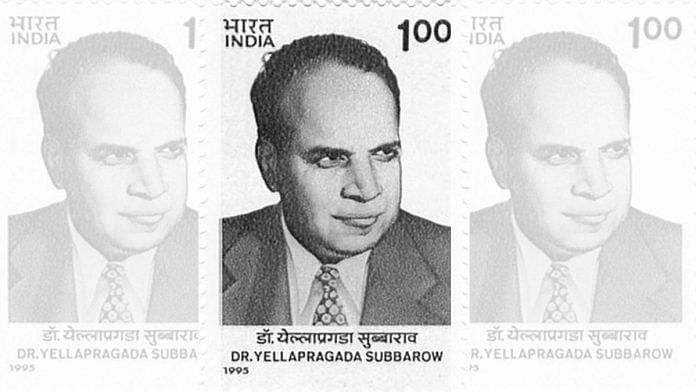Towards the tail end of the British Raj, there was a spike in Indian scientific research. One such scientist at the peak of their ability was Dr Yellapragada Subbarow, a biochemist whose work with the cell led to the discovery of the vital adenosine triphosphate or ATP—the energy source in the cell. He developed the first chemotherapy agent, methotrexate, which still helps treat cancer. And he was also the first scientist in the world to synthesise folic acid. But much of his work was destroyed by an envious colleague, setting research back by decades.
Having spent most of his professional life in the US, Subbarow spearheaded some of the country’s most important medical research projects during the Second World War. Despite his path-breaking achievements at Harvard, he was never granted tenure or professorship at the University.
He subsequently joined Lederle Laboratories in Pearl River, New York, which is today owned by Pfizer. At the lab, he headed the research department and started to develop novel drugs, focussing on anemia in pregnant women.
Born in Andhra Pradesh and educated in Tamil Nadu before heading to Harvard University, he died on 8 August 1948, in New York of cardiac arrest. Not many details are known or documented about him, and what is known is mostly from his biography In Quest of Panacea: Successes and Failures of Yellapragada Subbarow, a book by Sikharam Prasanna Kumara Gupta published in 1987.
Also Read: Harvard-rejected Indian, old physiologist & Black surgeon made US’ ‘most versatile antibiotic’
Bhimavaram to Harvard
Subbarow was born in Bhimavaram, in the erstwhile Madras Presidency, now Andhra Pradesh, in 1896. He had an unhappy childhood filled with rebellion. His father retired early because of illness and it all fell on his mother to run the household and provide for seven children. He did not perform well in school and failed Class 10 exams twice. His mother then sold her jewellery to send him to Madras (now Chennai) where he enrolled in Hindu High School.
Then he went to the Madras Medical College in Chennai for his MBBS degree in 1915. Here, he is said to have adopted khadi medical wear following MK Gandhi’s call to boycott British goods. This irked his British surgery professor and caused him to graduate with a Licentiate in Medicine and Surgery degree instead of MBBS, despite doing well in written exams.
Subbarow briefly contemplated studying Ayurvedic herbs to evaluate their efficacy scientifically, but after he met an American doctor visiting India, he decided he wanted to go to the US. He was offered financial support to pursue further studies at Harvard University. One of his patrons was the man who would go on to become his father-in-law, Kasturi Suryanarayana Murthy.
He obtained his Diploma of the Harvard School of Tropical Medicine in June 1924 and joined the biochemistry faculty upon graduation as a junior professor under a scientist named Cyrus Fiske. He also got his PhD degree at the institute.
After Harvard continued to deny him full professorship, Subbarow joined Lederle Laboratories in 1940 and started to develop new drugs. He kept working at the lab as the director of research till his death in 1948.
His crucial work gained him entry into biochemistry textbooks while he was alive, but his achievements went widely unrecognised by the scientific community.
Also Read: More and more Indian women are becoming anaemic, rise steepest in Assam, J&K, Ladakh
Anemia, chemotherapy agent and more
At Harvard, he worked with Fiske, and developed the Fiske-SubbaRow method to calculate the amount of phosphorus in bodily tissues. Subbarow’s work in understanding the biological cell led him to discover the role of creatinine phosphate and ATP as the energy providers to the cell. He found that creatine phosphate leads to the creation of ATP during the first few seconds of large muscular activity.
The discovery of ATP’s role in the cell was a major breakthrough, and became the basis for future studies.
At Lederle, he continued the work that Lucy Wills, a British researcher, had started on amemia in pregnant women in India in the 1920s. She had recognised the role of folates (Vitamin B9), and Subbarow developed a way to synthesise stable folic acid to protect against anemia, especially in pregnant women.
Developing on this work, he worked with paediatrician Sidney Farber, often called the father of modern chemotherapy. Subbarow went on to formulate the drug methotrexate, one of the earliest, if not the first, chemotherapy agents. Farber developed chemotherapy using this drug which is still used widely and frequently today.
He discovered the molecular functioning of diethylcarbamazine, which began to be used for the treatment of the tropical parasitic disease caused by roundworms, filariasis. It also aided in keeping American soldiers safe in tropical regions during the Second World War.
Subbarow also guided multiple juniors and students with their work. Under his guidance, plant physiologist Benjamin Duggar discovered the first tetracycline antibiotic, chlortetracycline, in 1945.
Also Read: Upendranath Brahmachari—forgotten Bengali scientist behind kala-azar cure got 2 Nobel nods
Destroyed body of work
Subbarow’s legacy lies largely within the community of scientific research and medicine, which uses his work on a daily basis today.
However, during his lifetime, not only was he unappreciated by Harvard, his work was also suppressed and destroyed by his former professor Fiske. That’s how much of Subbarow’s research and discoveries got lost. Scientists who came after him discovered them again, decades later.
His colleague, George Hitchings, who shared the Nobel Prize with James Black and Gertrude Elion for their work on drug development and chemotherapy, said, “Some of the nucleotides isolated by Subbarow had to be rediscovered years later by other workers because Fiske, apparently out of jealousy, did not let Subbarow’s contributions see the light of the day.”
(Edited by Ratan Priya)




